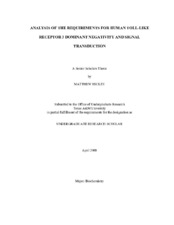| dc.description.abstract | Toll-like receptors are an important part of the innate immune system and mediate infection via the recognition of pathogen-associated molecular patterns (PAMPs). Toll-like receptor 3 (TLR3) recognizes foreign-derived double stranded RNA as its ligand, and is active as a homodimer. Previous research has indicated that specific residues in TLR3’s extracellular domain (ECD) are responsible for dimer-dimer interactions between TLR3s, and the apparent specificity of this interaction has allowed for modulation of TLR3 signal through the use of dominant negative mutants. Here we present a class of mutants which lack the inter-disulfide cap region of the ECD (Δ123-635, hereafter called TLR3N-CT), yet still exhibit dominant negative properties. The degree of dominant negative inhibition of TLR3N-CT is comparable to that of TLR3 ΔToll interleukin-1 receptor (TIR), the previously established standard for dominant negativity. Tyrosine mutants, such as Y759F, have been shown to dramatically reduce TLR3 signal induction by interfering with cytoplasmic signaling adapters. Our mutant, TLR3N-CT Y759F, retained the ability to act as a dominant negative inhibitor of TLR3, thus indicating that the observed reduction in induced/uninduced signal was not due to ligand-independent activation of the mutant. Furthermore, the mutant TLR3N-CTΔTIR was generated to investigate the role of the cytoplasmic TIR domain in dimer-dimer interactions. This mutant was not a dominant negative inhibitor of TLR3 activity, indicating a possible role of the TIR domain in the dominant negative interaction between TLR3N-CT and wild type TLR3. It is possible that this TIR-TIR interaction is either in the incorrect confirmation for signaling or, contrary to previous reports that ligand binding and dimerization are necessary only to bring the TIR domains together, that more than simple TIR-TIR interaction is required for TLR3 signaling. However, expression studies by western blot have been unable to prove expression by any of the mutants previously discussed. Several explanations are possible, but it is likely that expression levels are sufficient for cell-based activity assays but too low for western blot detection. | en |


